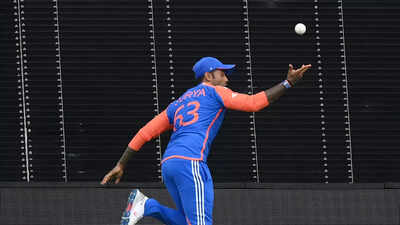The International Cricket Council (ICC) has unveiled a series of pivotal changes to the playing conditions across Test, ODI, and T20I formats. These adjustments target issues such as over rates, ball management, boundary catches, concussion protocols, and wide deliveries, aiming to enhance the game's flow and fairness.

Image credit: ICC
To combat slow over rates, the stop clock rule, previously tested in white-ball cricket, will now be permanently integrated into Test matches. After an over is completed, the fielding team has 60 seconds to begin the next. Teams will receive two warnings per innings, with subsequent violations incurring a five-run penalty. These warnings reset after every 80 overs, coinciding with the availability of a new ball.
The existing rule of using two balls in ODIs will now be limited to the first 34 overs. For the remaining 16 overs, the fielding side will have the option to choose one of the two balls to continue play. The change is intended to improve the management of ball wear.
A fielder making an airborne catch near the boundary must ensure their first point of contact after touching the ball is within the field of play. If the fielder steps out of bounds and jumps again, they are allowed only one additional touch before landing inside the boundary to complete a legal catch.
Under the updated guidelines, teams are required to pre-nominate concussion substitutes. Players diagnosed with a concussion will be mandated to undergo a seven-day rest period before they can return to competitive cricket.
A new wide ball rule will be tested in white-ball formats. The batter's position at the time of delivery will determine whether a ball is considered wide. Deliveries passing between the leg stump and the extended protected area marker at the popping crease will not be called wide. However, deliveries passing behind the batter's legs will still be considered wide. The protected area marker will be extended to the popping crease to help umpires.
The Decision Review System (DRS) will now utilize the actual physical outline of the stumps and bails to define the wicket zone. This change seeks to increase accuracy in LBW (leg before wicket) decisions.
In addition to the existing five-run penalty for a deliberate short run, the fielding team will now have the option to choose which batter takes strike for the next delivery.
In domestic first-class cricket, a player who sustains a serious on-field injury at any point after the match begins can be replaced by a like-for-like player for the remainder of the game. This includes injuries sustained during warm-ups.
The new Test playing conditions were effective from the Sri Lanka vs Bangladesh Test on June 17. The revised ODI and T20I rules will be implemented starting with the Sri Lanka series, with the first ODI on July 2 and the T20Is from July 10. All international matches after these dates will adhere to the updated regulations.
Newer articles
Older articles
 Gavaskar Calls for Kuldeep Yadav's Inclusion in Second Test Amid Bumrah Fitness Concerns, Cites Edgbaston Spin Advantage
Gavaskar Calls for Kuldeep Yadav's Inclusion in Second Test Amid Bumrah Fitness Concerns, Cites Edgbaston Spin Advantage
 Indian Astronaut Shukla Arrives at ISS, Ushering in New Era for Space Program
OR
India Celebrates as Shukla Reaches ISS, Advancing Ambitious Space Goals
Indian Astronaut Shukla Arrives at ISS, Ushering in New Era for Space Program
OR
India Celebrates as Shukla Reaches ISS, Advancing Ambitious Space Goals
 Rishabh Pant Revolutionizing Cricket, Says Greg Chappell
Rishabh Pant Revolutionizing Cricket, Says Greg Chappell
 Toxic Workplace Warning Signs: Spot the Red Flags Early
Toxic Workplace Warning Signs: Spot the Red Flags Early
 Global Immunization Crisis: Millions of Children at Risk as Vaccine Coverage Lags, Study Reveals
Global Immunization Crisis: Millions of Children at Risk as Vaccine Coverage Lags, Study Reveals
 Indian Cricket Star Mukesh Kumar and Wife Divya Singh Announce the Arrival of Baby Boy
Indian Cricket Star Mukesh Kumar and Wife Divya Singh Announce the Arrival of Baby Boy
 Moto G54 Price Slashed in India: Check Out the Discounted Rates and Specs
Moto G54 Price Slashed in India: Check Out the Discounted Rates and Specs
 IRCTC Launches AI Chatbot 'AskDisha 2.0' to Revolutionize Train Ticket Booking and Customer Service
IRCTC Launches AI Chatbot 'AskDisha 2.0' to Revolutionize Train Ticket Booking and Customer Service
 Cummins Lauds Australia's Dominant Start to WTC Campaign After West Indies Series Win
Cummins Lauds Australia's Dominant Start to WTC Campaign After West Indies Series Win
 Smith Targets Test Return After Innovative Baseball Cage Rehab in New York
Smith Targets Test Return After Innovative Baseball Cage Rehab in New York